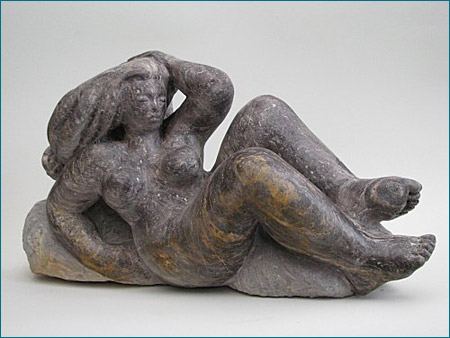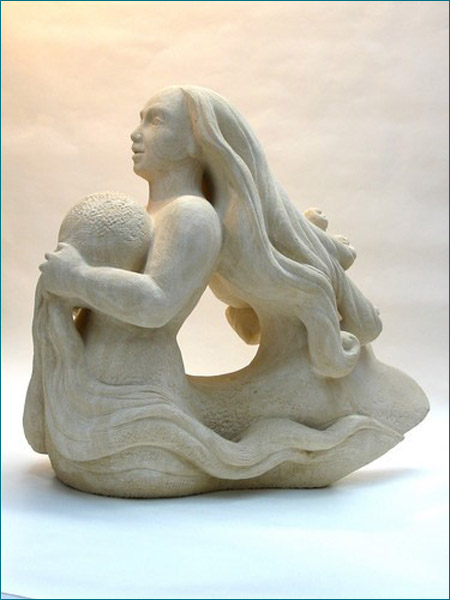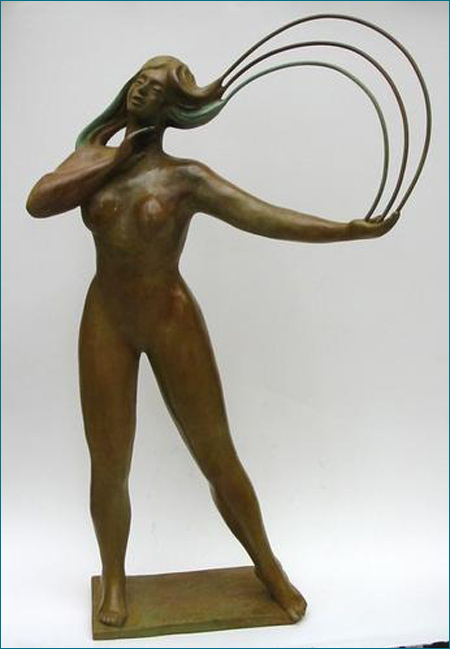 |
Dan Robert, the sculptor, stops in front of a piece of stone.
A question can be read on his face: what will I make out of it?
Can this mass be used? Does it conceal someone or something?
He fingers it, analyses it. The piece of stone seems to answer those hands that assess it. He suddenly is abandoned: no, there is nothing there, I cannot do anything out of it, and neither its matter nor shape will allow me to transmute it into a living thing…
He will look somewhere else, for a material whose weight, grain, consistency and a series of propertie, which he alone can perceive, will tell him he can make a work out of it. Sculpting is a manual work, one has to move pieces of stone, marble, heavy bags of clay. These materials have their own mechanical requirements. One cannot impose any kind of stress on them; one must know what can and what cannot be expected from them. By inspecting a mineral, feeling the weight of it, by running experienced fingers over it, the sculptor sounds its potential and, somehow the docility or the resistance it will show when he will have started working with it. |
|
 |

Le réveil |
|
From the soft, calcareous, semi-hard stone to the compact stones such as alabaster, steatite, onyx, the artist-craftsman can guess what each of these minerals provides in terms of specific resources and what he can get out of them. When cutting the stone, Dan Robert plays with all the aspects that it can take on. The epidermis of his statues goes from the perfect polish, both silky and shiny to the rugged surface obtained by the hammering chisel strokes. He can leave some grainy surface areas or smoothe them neatly with fine sandpaper. He knows how to render the color of flesh with marble. This marbre, almost warm to the touch, which he often choses with a shade of colour, speckled with colored veins, suggesting a quivering of the organs under the skin. There is sometimes a discrete evocation of details: he sculpts some scales on certains parts of the mermaids’ bodies, the folds and striations of a hairdo come to caress a smoothed-surface and plain torso. Some drapery adds a light thickness to a skin so as to underline the curve of a breast, the buttocks, a hip, or to prolonge in the space a curve or a movement. This movement is captured by the sculptor at the very moment when it is the most expressive. He will either distort or amplify it if necessary to make its meaning strike even more the viewer. He knows, in a compact material, how to translate dynamism, lightness. His chisel follows the curves of the waves, of the hair, of the delicate folds in fabrics and even succeeds in materializing the blowing f the wind and the impalpable rays of light. Dan Robert often stumps too precise elements which would harm the whole. He seeks harmony, beauty. There is no break, no rupture, in his representations. The combination of a shape with another occurs with ease. He links two volumes in order not to stop the viewer’s eye. He is particularly careful that the emptiness and fullness counterbalance, that the space that envelops his sculpture is coherent. And, in particular, he makes sure that, when going around his work, one discovers a whole succession of balances arising harmoniously the ones from the others. In his statues, there are some gaps across the matter that allow the air and light in. He plays with the shadows which, although immaterial and changing, play a paramount role. Just move a lampa round a sculpted piece of stone and you will be amazed at the diversity of the aspects obtained depending on the direction of the light. The artist knows how to use these variations of light to accentuate or diminish the volumes. He will also consider the drop shadow projected by his sculpture because our eye will naturally integrate it to the sculpture, even if unaware.
Dan Robert's creations radiate plenitude, harmony and softness. Many other artists will turn instead to expressions of energy, virile viguour or even violence. They will chose harsher, more aggressive and chaotic shapes. They make representations of beings and things whose aspect will disturb or move the viewer deeply. Yet, there is in the desire to only evoke what is good and nice the same underlying force as in the expression of the opposite. The artist has had the will, here again, to take on a hard and compact material and extract a figure, until then virtual, that he wanted to snatch back from the void. It was necessary to have the courage to say, to signify and to impose a particular vision by turning an inert and obtuse mineral into a meaningful work.
The creature the sculptor gives life to has, beyond its immediate, so to speak narrative significance, a broader meaning. It conveys the character, the feelings, the thoughts of the one who has given birth to it. I also translate, in particular, his own vision of life. Dan Robert's work expresses both kindness and harmony simply because these values are part of him, but it is indeed the message he wants to pass over. His women express the joyful passion, sensuality, the motherly love… his children are loving and gracious Cupids… his sirens are not those man-eating creatures that used to attract sailors by singing in order to eat them up, they are nereids that voluptuously frolic in a large and fertile sea. He has gestures of tenderness towards his own works. He considers his child, his daughter, the woman he has shaped; she is complete, or almost… He is entitled to intervene.
He alone may modify her. He strikes her with the eye and the hand. He then takes his chisel and very slightly corrects a shadow; with some sandpaper, he further polishes a surface; he meticulously rasps an imperceptible flaw. The sculpted figure seems to let him do and accept this careful and tender hand that perfects it, like a child whose face is washed by the mother.
|
|
 Sirène Sirène
|
 |
There is in the giving birth by the sculptor of a feminine shape a particular element: this image is the reflection of his desire. He is under the influence of the charm exerted by the materialization of his fantasms. By springing up from the material itself, she will start existing by herself and assert her own will. The creator will enjoy instant exchange with his creature that will guide his initiatives in the same manner as a lover would do. The time of creation will be accelerated taming, mutual education, a time of love and plenitude that final polishing will complete in multiple, intertwined caresses. But although a woman, this work not only is the receptacle of a particular libido. The artist strives towards a broader intention. He does not ignore that the desire in him is that of any life longing for reproduction and that it has been, since the dawn of time, the drive for any creation. The material from which he extracts it is a promise for immortality. Engraved or sculpted stones, marbles, bronzes, have in all times resurfaced to tell man what the gods, kings and drams of their predecessors have been. Hence, the woman will not only be the representation of a cherished and desired flesh, she will join the very first symbols. She will also be both a goddess and entity. She will be Eve, the mother of humanity or Isis, the feminine principal of generation, or Demeéter, the patron of any blossoming and fruit.
She will be Ge, our Earth, heavy and carnal, ready for all birthings. As universal mother, she is accompanied by primordial waters, and is bathed in the rays of the original light. She is surrounded by the spheres of the planets, the sun and the moon, by the wind and the clouds. She knows that she is linked together via her matrix to the entire creation and this is the very reason why she often bears her fruit: the child. The stone child who was first concealed within the compact block of stone as the child in the woman’s breast. She shows it as evidence that she too is capable of giving birth to a weight of flesh in which the spirit glimmers.
A large number of sirens have been shaped by Dan Robert's hands. They are his daughters, his creatures. Combining in them two elements, they are hybrid beings capable of living and breathing in air or water. They are the figureheads of the huge marine environment where life once started.
Her caudal fin makes the siren a fabulous being. With her strong, elastic tail, vigourous extension of the body, a rudder made of flesh, muscle developped by swimming, which can suddenly hit the water, make the foam of the sea spring, powerfully lift the waves and overturn with a thrust the fisherman’s boat. |
|
It drives the siren, makes her revolve within the three-dimensional space in which she moves along. It propels her towards the marine depths or makes her jump over the waves. The sculptor gives her all the potentials of a living member: at rest, the siren leans softly within the comfort of her own flesh or lets it prolonge her body as an ondulation which will join the waves. Sometimes folding it under her body, sometimes sitting up majestically like a king cobra. This appendix is also, for the sculptor, a fertile S, an infinite possibility of volutes, spirals… This massive shape that replaces the dual volume of the legs coils around the body, folds around it, underneath it. It is sometimes horizontal as that of the fish, sometimes vertical as that of marine mammals. The two parts that end the body wave like flags or chop the air like blades. This bifid end, sometimes as high as the siren herself, reaches her sides, arms, face and hair to caress them. This hair which both prolonges and imitates the waves. It has the fluidity and curves of the waves and the curls join together and come undone around the silhouette of the mermaid, caressing it, splitting into wet tufts underlining her shapes and repeating the arabesques that outline the body.
Dolphins and whales alike, the siren has some nourishing teats and the appendix that makes her also an animal, condemns the one who desires her to the temptations of bestiality. Who is her partner, her lover? A dolphin, a newt, a man? By which orifice can he possess her, enseminate her? Will she lay eggs from which newt children will come out? Could she simply bear human babies? There is not, in her anatomy, the location of a female sex. Is she only an appearence, reduced to her anatomic strangeness? If she is only a shape, there seems no possibility for her to live a carnal life. And yet… She is a woman, she is naked and the one who looks at her contemplates through her own desire: the curves, the breast, the lips, the eyes, the regard… Why not sensations, feelings, thoughts? Her human shape gives her access to everything that is human. The expression of joy, sadnes, serenity that the artist has given to her provides her all the others feelings that a human being, a woman, may have. As soon as she has a face and a body, she lives! And even though she is mute, even though a stone or bronze nereid may not bewitch through her songs, she is, with the undulations of her fins, of her body and of everything that coils and fluctuates around her, the embodiment of harmony.
Dan Robert, who knows how to create movement and lightness from this heavy and compact mineral that is stone, will, when passing over from stone to bronze, provide an even greater feel of aerial grace. Bronze has a specific gravity much higher than that of a body, but Dan Robert frees his characters from it. His metal women jump, raise the arms, are captured in a balance on one foot, while runing, dancing, reaching towards the sky, their hair and clothes floating behind them and the air blowing on their stretched faces. He will even add some more liberated, finer accessories that allow his characters to grasp even further the space surrounding them: he makes them fly a kyte that our eye is ready to follow in the air, a string that will vanish in the heights, rings that will twirl around above our heads. These slender creatures are the movement, rhythm and momentum.
Beyond that, they may become the vector of all allegories, of all abstractions: the liberty, nude and jumping that will release in the skies the bird that she brandishes. The triumphing Europe, surrounded by the ocean and the wind, the svelt Victory, with raised arms, expressing the joy with her entire body. The outline suggests the content: the thought is inside the shape itself. The sculpture is a “condensed” world. A global meaning should be contained in a single mass. The artist must have enough force of persuasion to provoke in the viewer feelings and reflection. The appearence should be explicit. The curve, the gesture, should be the meaning. Everything should be expressed in one go.
|

L'arc en ciel
|
 |
These bronzes possess one additional appealing characteristic: they are colored. When coming out of the mold, the sculptor turning into a painter, works out the sheen with which he will cover their naked bodies. He will use all the shades, from gold brown to blueish green, providing each single sculpture its specificity. He will give his works the colors of oxides: that of iron: red brown, that of copper: blueish green or that of semiprecious stones such as jade, onyx, turquoise. There lies alchemy in it whose secret is jealously kept by the sculptor in the same manner as painters used to keep the recipe of their pigments. This sheen, under the extreme heat of the blowtorch, will take on more or less deep reflections, a range of more varied tones, which will enhance further the curve of the feminine shapes and bestow to it the magnificence of rare materials.
The volume is the result of a series of lines which intertwine like the course of the laser beam that encircle the shape in order to then reconstruct it. The woven lines have been drawned in the mind by the eye of the artist in order to recreate the density, the contours, and everything this mass has to contain as feelings and human thoughts. Just as the brain, projecting its optic nerve towards the face of a fœtus to bring forth an eye, each point of the surface has in depth a sensitive root. This gets hold of its interior meaning, even of this compact mass, blind in appearance, in order to rejoin externally this network which delineates it exactly and which stops at the moment that it attains perfection.
The sculptor knows that the shape is the meaning itself. We can recognize in a person a distrustful or a serene attitude, the spitefulness or the benevolence of a physionomy… The artist does not read the information from the expression of a face, of a body, but from the shape itself. Such curves, such volume will have an explicit content: they will obviously evoke joy, fear or animosity, without requiring a caption to make it clear. We spontaneously tell the meaning of a movement of tenderness, of a hostile gesture. We also know what an acute and sharp shape or a round and full shape mean. We attribute to the former aggression whereas the latter is associated with gentleness and sensual delight. When animals for example deploy their claws or pincers, it is not only to use them against their enemies but also to tell them: beware and the other animals, be it an insect, a bird or a mammal, including man, clearly understand the rules of that specific language. It is true that some animals display sharp tools although they never use them: shapes speak for themselves. We also know how to decipher them, and the artist knows how to use them. A shape with spikes will make us feel the threat at a distance. We will feel the smoothness or the morbidness of a fur, of a skin, by striking it just with the eye. Our long history has written these messages in our genes and this language is used by the sculptor to move us, convince us and explain to us the kind of world that was part of him.
|
|
| Everything that lives, seeks to evolve, to be transformed. Because nature is also a sculptor. Or rather, each species has set out to explore all the possibilities of his further development by using the language of shapes, by varying them to the infinite. Have those changes occured with a view to gain power or a better-advised use of the habitat? Maybe, possibly also extravagance, exuberance, pure creation. Why not? The artist, the sculptor, fits into this nature’s grand parade, into its ability to change, to invent. In this sense, he is living among the living. He has become aware of this large creation movement and has had the deisre, on his own scale and in his own field, to be part of it. |
 |
| top |
|
|